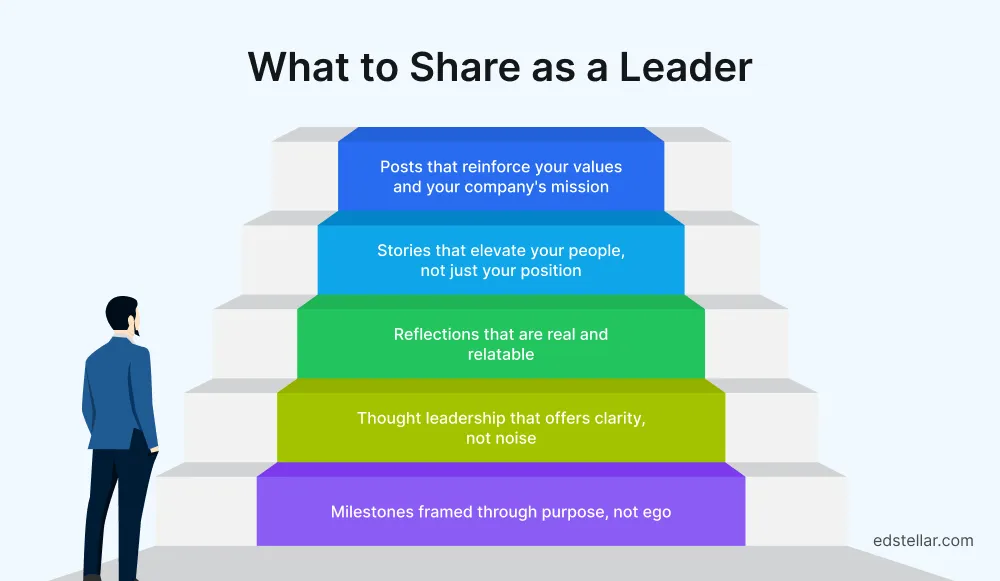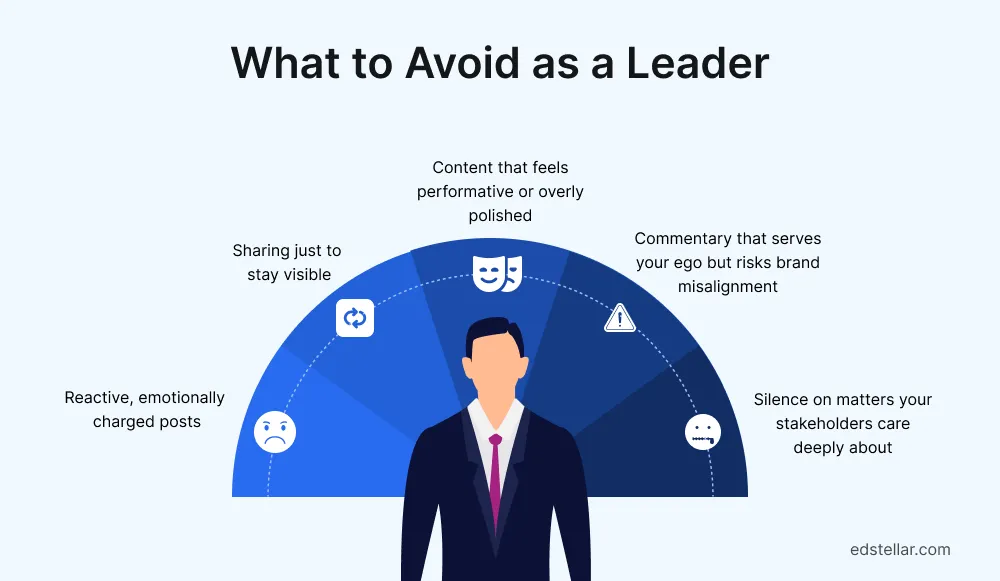
At 9 p.m., when employees are scrolling LinkedIn or reading a quote you gave the press, they're not just learning what your company does; they're deciding what kind of leader you are.
And in 2026, that impression matters more than ever.
The age of leading quietly behind closed doors is over. We live in a hyper-visible world where every leader is now a public figure, whether they choose to be or not. Employees, customers, and investors they're reading your posts, watching your interviews, and forwarding your thoughts to their peers.
This shift began in 2020, when the pandemic blurred the line between office and online. Hybrid work eroded the visibility once built in through hallway conversations and in-person town halls. In response, leadership had to evolve. Presence had to scale. And platforms like LinkedIn transformed from talent marketplaces into primary arenas of leadership influence.
If your voice isn't out there, your values are invisible. And that's a risk no board can afford.
Today, social media isn't a PR channel; it's a leadership tool. One that scales trust. One that humanizes strategy. One that connects you to people before they ever walk into your company or walk out.
The question isn't whether leaders should be on social media. It's whether you're letting someone else define your leadership while you stay silent.
The New Expectations from Leaders on Social Media
Not long ago, social media was dismissed as the domain of marketers, influencers, and Gen Z. It wasn't a space where you'd expect CEOs or executive leaders to spend time, let alone speak openly.
Today, the rules of leadership have changed. Employees want to know the values of the people they work for. Customers want to trust the humans behind the brand. Investors want to see the face of governance and culture.
These aren't assumptions. Data validates their expectations.
According to a Weber Shandwick report:
- 76% of executives believe it's a good idea for CEOs to have a social media presence
- 73% of executives with social CEOs regularly check what their CEO is posting
- 69% of executives wish their CEOs posted even more frequently
So, this is why the idea of the Social CEO has gained traction. Because in a noisy digital world, silence is interpreted as absence.
Why Social Media Risks for CEOs are Worth Taking
It's true that being visible comes with responsibility. The same Weber Shandwick report notes that over half of the executives surveyed (56%) believe there are risks involved with CEOs being active on social media.
The fear of misinterpretation, backlash, or being taken out of context is real. And in a digital world where one post can go viral for the wrong reasons, that fear makes sense.
But here's the shift we're seeing: the benefits now outweigh the risks. In fact, the report predicts that there will be a 50% increase in social CEOs over the next five years. The tide is turning, and leaders who lean in will be the ones who connect better, communicate faster, and inspire deeper trust.
- 80% say it’s an effective way to share important company news
- 78% believe it improves brand and leadership reputation
- 70% tie it directly to better business performance
- 75% believe it strengthens internal communication with employees
- 72% say it helps CEOs stay in touch with what's really happening inside the company
- 69% agree it enhances a leader's credibility in the market
- 64% say it helps attract new customers
- 61% believe it makes CEOs more effective in managing crises
In short, the world wants leaders to be more visible and values them more when they are.
Leadership in the Social Media Era
What's emerging is a new expectation: leaders who are not just visible, but intentional. People no longer want leaders to hide behind silence or let others speak for them. They want leadership that feels real, even if it's not always polished.
This doesn’t mean every leader has to become a content creator. But it does mean having a point of view. Knowing what needs to be said.
Whether it’s a short reflection, a company milestone, or a public stand on something that matters, leadership today requires a visible presence that reflects more than strategy. It reflects character.
4 Examples of Positive Social Media Leadership
Now we'll look at what this social CEO looks like in action. From tech giants to wellness icons to bold disruptors, we will analyze how some of today's most visible leaders are using social media not to build their image, but to build their brand.
1. Satya Nadella, Chairman and CEO at Microsoft
Despite commanding millions of followers, 11.4M on LinkedIn and 3.4M on X, Satya Nadella doesn’t flood the feed with noise or trend-chasing. Instead, he leads with precision, thoughtfulness, and a tone that mirrors the steady clarity people expect from a CEO of his stature.
Instead, what you’ll see is a masterclass in calm, values-aligned leadership presence.
On LinkedIn, Satya treats his profile less like a newsfeed and more like a thoughtful journal of Microsoft’s purpose in action. He posts sparingly, maybe once or twice a month, but every post carries weight. Whether it’s a product milestone, a breakthrough AI partnership, or a spotlight on a Microsoft intern, the tone remains composed, reflective, and mission-first.
He often shares:
- Milestone Moments like Microsoft’s work with OpenAI or advancements in accessibility tech
- Employee Stories that humanize leadership and reinforce internal culture
- Impact Narratives about how Microsoft tools are being used by nonprofits and global partners
- Future-Facing Reflections on AI, sustainability, and inclusive innovation
On X, most posts are brief acknowledgments or retweets of Microsoft announcements. You won’t find him debating online, reacting emotionally, or veering into political terrain. He uses X as a short-form amplifier, not a commentary zone.
So what does this tell us?
It tells us that you don’t have to be loud to lead well online. Satya’s social media reflects what employees and stakeholders want in a modern leader:
- Someone who’s clear but not performative
- Visible but not self-centered
- Strategic but still human
And that’s the takeaway for leaders today: The goal isn’t to go viral. It’s to show up consistently with purpose, alignment, and clarity.
2. Ben Francis, Founder and CEO of Gymshark
Ben Francis, founder and CEO of Gymshark, shows us how social media can be a space for honest leadership, authentic storytelling, and community-powered growth, especially for the next generation of CEOs.
As of mid-2026, Ben commands a highly engaged, multi-platform audience:
- ~650K followers on LinkedIn
- 600K+ followers on Instagram
- Around 60K followers on X
- Over 1.8 million followers across Instagram, LinkedIn, TikTok, YouTube, and X combined
Yet, despite this massive following, Ben never comes across as loud, performative, or ego-driven. His tone remains grounded, relatable, and consistently aligned with Gymshark’s culture.
Ben’s Instagram is a visual narrative of his growth as a founder and the evolution of Gymshark. His posts are authentic, thoughtfully personal, and rich with meaning.
He shares:
- Behind-The-Scenes Moments from Gymshark HQ (e.g., office tours, product development)
- Personal Reflections on leadership, responsibility, and learning from mistakes
- Business Milestones such as store openings and major campaign launches
- Family, Fitness, and Values that shaped his entrepreneurial journey
The tone is casual yet focused. Nothing feels forced or overly curated. His audience doesn’t just double-tap; they engage, comment, and contribute, making his Instagram a genuine two-way conversation, not a one-way performance.
On LinkedIn, Ben crafts a distinct narrative that balances confidence with humility. His content speaks directly to business audiences and aspiring entrepreneurs.
He uses the platform to
- Celebrate Team-Driven Milestones, not just personal achievements
- Share Lessons Learned from humble beginnings to leading a billion-pound brand
- Reflect on Gymshark’s Evolution, culture, and broader mission
What stands out is how he resists the urge to self-promote. Instead, he positions his journey as an invitation, not a highlight reel. The result? A credible leadership presence rooted in purpose, not persona.
Ben’s approach isn’t about building a personal brand for visibility—it’s about shaping a leadership voice that stays grounded in values, culture, and growth. His social presence feels more like an ongoing conversation than a performance. That’s what earns trust in today’s leadership landscape.
3. Arianna Huffington
Arianna Huffington doesn’t use social media to position herself. She uses it to reposition the conversation about success, burnout, leadership, and what it means to truly thrive in today’s world.
When you land on her LinkedIn feed (with over 9.3 million followers), you’re not met with titles or self-congratulations. You’re greeted by a woman who proudly leads with “sleep evangelist” just as much as “CEO.” That subtle shift says everything: for Arianna, leadership is not about image. It’s about impactful presence and redefining the metrics of success.
Arianna’s posts weave personal stories, research-backed insights, and leadership reflections into content that connects, not just informs. Whether she’s talking about microsteps to avoid burnout, spotlighting science-backed workplace practices, or sharing what she’s learning through Thrive Global’s partners, she brings empathy into the digital space with rare consistency.
There’s a gentleness in how she writes, but also a firm truth. She stirs self-awareness. Her social presence reminds you that the way you show up in leadership is not just about what you say. It’s about what you believe, and how you live that belief in your organization’s culture.
Her feed is a blend of:
- Practical wellness frameworks for leaders and teams
- Candid reflections on sleep, burnout, and high-performance myths
- Storytelling that doesn’t separate “work” and “life” but shows how they coexist
- Gratitude-filled posts that elevate others working toward similar missions
What stands out is the voice. She doesn’t need to post every day, because when she does, it’s
intentional. It carries weight. Her posts aren’t scheduled for visibility; they’re written to resonate.
She engages with the community, responds to stories, and celebrates wellness allies not as PR, but as a manifestation of her own philosophy: connection is more powerful than perfection.
What can leaders learn from Arianna?
Leading on social media is not about keeping up; it’s about slowing down enough to say something that matters.
Being consistent in your message builds more trust than being constantly visible.
That is when your brand and your values are one and the same, your presence online doesn’t need performance, it needs honesty.
4. James Watt, Co-Founder of BrewDog
When James Watt uses social media, he unleashes himself. Whether it’s announcing a new venture, admitting to a 20-year marketing mistake, or turning his engagement into a faux press release, Watt posts like a man who never left the BrewDog brewery floor, loud, irreverent, and allergic to polish.
And that’s exactly the point.
Watt built BrewDog with a punk ethos, and that attitude bleeds into every sentence he writes online. There’s no PR glaze, no “best version of self” filter. His tone is chaotic, driven, often brilliant, and sometimes jarring. But here’s the thing: he’s consistent. And in the world of leadership on social media, that’s a rare form of authenticity.
His LinkedIn feed is part confession booth, part founder diary, part startup pitch deck. He admits to getting marketing wrong for decades. He celebrates his wins without humility. He shares his next business idea, a platform called Social Tip that lets everyday people earn rewards for brand advocacy, like it’s a revolution (and maybe it is). Even his personal milestones, like getting engaged, are packaged in business lingo: “a long-term contractual agreement poised for future growth.” Some called it cringeworthy. Some called it genius. But everyone clicked.
That’s Watt’s power. He knows how to own attention.
But visibility comes with shadows. While supporters see a trailblazer who says what others won’t, critics see a leader who sidestepped serious accusations about BrewDog’s internal culture. The same no-filter voice that draws followers can also backfire when accountability is expected. And that’s where James Watt becomes more than a case study; he becomes a paradox. Is radical transparency still transparency when it’s selective?
That tension is what makes Watt such a compelling and cautionary example. He doesn’t chase the idea of a personal brand. He builds movements, embraces friction, and owns the reactions he sparks.
Watt’s digital presence reminds us that visibility without responsibility can be risky, but visibility with intention can shape movements. His style may not be for everyone, but his willingness to be seen, speak directly, and stir reaction offers a powerful reflection: modern leadership isn’t about perfection. It’s about presence and owning its consequences.
What to Share and What to Avoid as a Leader
After looking at how leaders like Satya Nadella, Ben Francis, Arianna Huffington, and James Watt show up online, one truth becomes clear: there’s no single way to lead on social media. But there is one non-negotiable: you have to show up.
And the data backs it.
According to FTI Consulting’s research report, The CEO Brand and Its Impact on Business:
- 81% of the fastest-growing companies are led by CEOs who actively prioritize communication
- During the pandemic, these communicative CEOs helped protect $260 billion in shareholder value
In other words, your visibility matters. Not just to your employees, but to your peers, stakeholders, and the future talent watching you from afar.
The real question isn’t if you should be active. It’s what you should share and what you should steer away from.
Let’s make that clear.
What to Share on Social Media as a Leader
Not every post has to be profound. But everything you share should be intentional, aligned, and reflective of your leadership voice. Here's what consistently works:

- Posts That Reinforce Your Values and Your Company’s Mission: Whether it's Satya Nadella highlighting inclusive AI or Ben Francis showing how Gymshark lives its culture, this kind of content builds clarity and trust.
- Stories That Elevate Your People, Not Just Your Position: Employee spotlights, team milestones, and community collaborations show that your leadership is shared, not solo.
- Reflections That Are Real and Relatable: Arianna Huffington shares micro-habits, lessons from burnout, and sleep advocacy, not to sound perfect, but to share insights and connect.
- Thought Leadership That Offers Clarity, Not Noise: Share trends you're tracking, big-picture perspectives, or shifts you're seeing. Just make sure it's earned insight, not borrowed noise.
- Milestones Framed Through Purpose, Not Ego: Celebrating success is great, but grounding it in values makes it meaningful.
What to Avoid as a Leader
Visibility isn't valuable when it creates confusion, distrust, or contradiction. Here's what to steer clear of:

- Reactive, Emotionally Charged Posts: If it's typed in frustration, reconsider. James Watt's radical honesty works for his brand, but even he had to clarify posts under scrutiny.
- Sharing Just to Stay Visible: If you're posting because it's "been a few days," pause. Frequency without clarity leads to fatigue, not influence.
- Content That Feels Performative or Overly Polished: Leadership doesn't need filters. Audiences respond better to stories that feel lived, not staged.
- Commentary That Serves Your Ego but Risks Brand Misalignment: That clever quote or joke might go viral, but will it reflect the company you're leading?
- Silence on Matters Your Stakeholders Care Deeply About: Not every topic needs your voice. But when it relates to your people, your industry, or your values, absence can be louder than a post.
There is no one-size-fits-all social media voice for leaders. And the good news? You don’t need one.
You don’t have to be the most eloquent. Or the most insightful. Or even the most visible. You just have to be yourself, with intention.
That said, how you show up matters just as much as showing up at all. And that’s where social media etiquette comes in. It’s not about rules, it’s about respect, relevance, and responsibility. When your presence is guided by etiquette, your voice builds trust, not just visibility.
You already lead with purpose behind closed doors. Social media simply invites you to let others see it, too.
If you’re unsure where to start, start small. Share a reflection from your day. Spotlight someone on your team. Celebrate a value your company stands for. You don’t need to have “the perfect post.”
Remember:
- You don’t need to be loud to lead well online
- You don’t need to be everywhere, you just need to be where it matters
- And you don’t need to post constantly, just consistently with character
So yes, visibility matters. But so does voice.
And you already have one that people want to hear, because it comes from a place of experience, empathy, and purpose.
You’re not starting from scratch. You’re starting from strength.
Managing Crises and Backlash with Digital Maturity: Case in Point
In late 2020, news broke of one of the most sophisticated and far-reaching cyberattacks the world had seen, an infiltration so stealthy and systemic that it compromised government agencies, private corporations, and technology giants. The breach was later traced back to tampered updates in SolarWinds’ Orion software, quietly giving hackers access to critical systems across the globe.
Among the companies affected was Microsoft.
For many leaders, such a moment would trigger reflexive silence or tightly managed PR containment. But Microsoft chose a different path, one that demonstrated what digital maturity truly looks like in a crisis.
On December 17, 2020, Brad Smith, Microsoft’s President and Chief Legal Officer, published a public blog titled “A moment of reckoning: the need for a strong and global cybersecurity response.” It wasn’t a defensive memo. It wasn’t sanitized for optics. It was, instead, a strikingly candid and measured account of what had happened and what the world needed to reckon with next.
From the very first line, Smith made it clear: Microsoft wasn’t distancing itself. It was a step forward.
He didn’t speak like a spokesperson. He spoke like a leader owning the weight of the moment, acknowledging the scale of the threat, recognizing the shared vulnerability across public and private sectors, and urging a collective, global response to an increasingly complex cybersecurity reality.
Behind the scenes, Microsoft had already mobilized its security teams, engineers, and legal experts. But on the surface, what the world saw was this: a company that refused to let the narrative spiral into speculation. Instead, they wrote their own deliberately, transparently, and in public view.
Brad Smith’s blog wasn’t the only signal. Microsoft’s Security Response Center, its threat intelligence teams, and other executive voices aligned their updates across platforms from detailed technical breakdowns to collaborative advisories for customers and partners. They didn’t flood the internet with panic-driven messaging. They paced their communication, balancing urgency with composure.
Even personal platforms like LinkedIn were used thoughtfully. Brad Smith’s leadership voice remained steady, never performative. No blame games. No overpromising. Just a clear articulation of what the company knew, what it was doing, and what the broader industry must consider going forward.
This was strategic narrative control, anchored in values. Microsoft didn’t shy away from the fact that its systems had been probed. But in doing so, they won something far more valuable than short-term reputation protection: enduring trust.
In the months that followed, Microsoft became not just one of the companies affected by SolarWinds but one of the leading voices shaping how the industry and government would respond to the future of cybersecurity threats. They opened source code access to security agencies, shared intelligence with competitors, and elevated the incident from a brand threat to a call for international cybersecurity norms.
There was no frantic thread of tweets. No CEO video confessional. Just consistent, intelligent leadership delivered with digital fluency and restraint.
For leaders watching closely, the message was unmistakable.
In the face of crisis, the instinct to protect the brand must be matched by the courage to lead through it. And in today’s digital world, how you communicate in those first few hours and where you choose to speak can define your entire legacy of trust.
Building a Thought Leadership Persona, Not a PR Shell
Corporate channels may still speak for the company, but it’s the leader’s voice that people truly lean into.
Today, audiences are growing increasingly tired of uninspiring brand posts. Algorithm shifts and digital fatigue have only made it harder for company channels to stand out.
But when a CEO or executive leader shares something directly? The engagement speaks volumes. In fact, CEO-shared content consistently receives far higher engagement than content from brand pages.
Why? Because leadership posts bring back what most brands lack: a sense of personality, realness, and presence.
According to FTI research, More than 90% of people believe that CEOs who participate actively on social media build better connections with customers, employees, and investors. And over 70% agree that this kind of engagement makes leaders more trustworthy and more effective. Leadership channels, in short, are not just PR tools; they’re trust engines.
Different Leaders, Different Styles, and Outcomes
But not all leaders show up the same way online. And the data tells us that how you show up matters just as much as if you show up.
FTI’s report categorized social CEOs into five types:
- The Generalist
- The Company Spokesperson
- The People Person
- The Purpose Champion
- The Crisis Communicator
Interestingly, Generalist CEOs made up the largest group, and they also posted the most. With an average of 73 posts over the study period (around 9 per month), they shared everything from strategy to personal updates. They were also the most engaged with the audience, receiving the highest number of total engagements and the second-highest engagement per post.
Even when Generalists posted about niche topics, crisis events, purpose, and ESG, they received more than double the engagement compared to those who only posted about those themes. Simply put: breadth of voice builds depth of trust.
Thoughtful Strategy Beats Random Activity
That doesn’t mean being random or reactive. On the contrary, the most successful social CEOs are deeply strategic. They post with consistency and clarity, but not from a script. They share about the business, yes, but also about themselves. Their opinions, their people, their values. They don’t just speak for the company, they speak as human leaders within it.
This balance is what sets thought leadership apart from PR packaging.
It’s not just about content output. It’s about building a leadership presence that reflects business strategy, personal conviction, and cultural connection, without losing voice to the corporate filter.
And the shift is clear: once driven by communications teams, leadership engagement is now increasingly initiated by the leaders themselves. Many have realized, especially in today’s remote and hybrid environments, that social media is where visibility lives. It’s how you show up where your people are. Especially in times of disruption, when trust is tested and clarity is critical.
Because in the end, leadership online isn’t about polish. It’s about presence.
Final Thoughts: The Presence You Build Now Shapes The Leadership You Become
In today’s world, where perception travels faster than policy and leadership is measured not just by what’s decided but by what’s said, seen, and shared, your presence isn’t peripheral. It’s pivotal.
The platforms have changed. So have the expectations. Employees look to leaders for cultural cues. Customers look for alignment between the message and the mission. Stakeholders scan for credibility, not just competence. And often, that first impression doesn’t happen in a boardroom or business report; it happens in a post, a comment, a reflection shared online.
Being a visible leader in 2026 isn’t about performative posting or chasing virality. It’s about strategic authenticity. It’s about showing up with your values, your insights, your human side, and doing it consistently enough to be counted on. Because trust doesn’t scale by accident, it scales through presence.
At Edstellar, we work with leaders who are ready to evolve how they communicate and connect. Through one-on-one coaching, digital fluency programs, and leadership visibility training, we help executives build a social media presence that reflects who they are and what their organizations stand for. Not just to gain attention, but to grow trust, clarity, and influence.
Whether you’re just starting out or looking to refine your voice, here’s the truth: you’re not too late to this shift. You’re right on time. You just have to start.
Explore High-impact instructor-led training for your teams.
#On-site #Virtual #GroupTraining #Customized

Bridge the Gap Between Learning & Performance
Turn Your Training Programs Into Revenue Drivers.
Schedule a ConsultationEdstellar Training Catalog
Explore 2000+ industry ready instructor-led training programs.

Coaching that Unlocks Potential
Create dynamic leaders and cohesive teams. Learn more now!


Want to evaluate your team’s skill gaps?
Do a quick Skill gap analysis with Edstellar’s Free Skill Matrix tool

Transform Your L&D Strategy Today
Unlock premium resources, tools, and frameworks designed for HR and learning professionals. Our L&D Hub gives you everything needed to elevate your organization's training approach.
Access L&D Hub Resources.svg)
.svg)



.svg)


.svg)
.svg)
.svg)
.svg)

